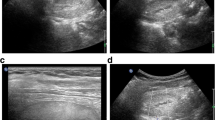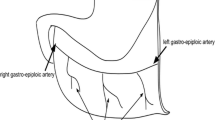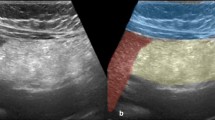Abstract
Segmental omental infarction (SOI) is an uncommon cause of right lower quadrant pain in children that is often misdiagnosed as appendicitis. During the last decade, imaging findings of SOI have proved to be sufficiently typical to avoid unnecessary surgery in the majority of reported adult patients. The condition has a spontaneous favourable evolution under medical treatment. In children the surgical option remains controversial. We report a typical case of SOI in a 10-year-old boy. The diagnosis was suspected by sonography, unambiguously confirmed by multidetector CT and successfully treated conservatively. This report emphasizes the use of CT in selected acute abdominal situations, peculiarly in obese children, to avoid unnecessary surgery.


Similar content being viewed by others
References
van Breda Vriesmann AC, Loble PM, Coerkamp EG, et al (1999) Infarction of omentum and epiploic appendage: diagnosis, epidemiology and natural history. Eur Radiol 9:1186–1192
Karak PK, Millmond SH, Neumann D, et al (1998) Omental infarction: report of three cases and review of the literature. Abdom Imaging 23:96–98
Mack P, Chellappa M, Sidhu DS, et al (1989) Acute omental infarction—a report of six cases. Ann Acad Med Singapore 18:710–712
Coulier B, Pringot J (2002) Pictorial essay. Infarction of the greater omentum: can US and CT findings help to avoid surgery? JBR-BTR 85:193–199
Coulier B, Cloots V, Ramboux A (2001) US and CT diagnosis of a twisted lipomatous appendage of the falciform ligament. Eur Radiol 11:213–215
Coulier B, Van Hoof M (2004) Intraperitoneal fat focal infarction of the lesser omentum: case report. Abdom Imaging 29:498–501
Abadir JS, Cohen AJ, Wilson SE (2004) Accurate diagnosis of infarction of omentum and appendices epiploicae by computed tomography. Am Surg 70:854–857
Sakellaris G, Stathopoulos E, Kafousi M, et al (2004) Primary idiopathic segmental infarction of the greater omentum: two cases of acute abdomen in childhood. J Pediatr Surg 39:1264–1266
Grattan-Smith JD, Blews DE, Brand T (2002) Omental infarction in pediatric patients: sonographic and CT findings. AJR Am J Roentgenol 178:1537–1539
Varjavandi V, Lessin M, Kooros K, et al (2003) Omental infarction: risk factors in children. J Pediatr Surg 38:233–235
Helmrath MA, Dorfman SR, Minifee PK, et al (2001) Right lower quadrant pain in children caused by omental infarction. Am J Surg 182:729–732
Schlesinger AE, Dorfman SR, Braverman RM (1999) Sonographic appearance of omental infarction in children. Pediatr Radiol 29:598–601
Author information
Authors and Affiliations
Corresponding author
Rights and permissions
About this article
Cite this article
Coulier, B. Segmental omental infarction in childhood: a typical case diagnosed by CT allowing successful conservative treatment. Pediatr Radiol 36, 141–143 (2006). https://doi.org/10.1007/s00247-005-0025-x
Received:
Accepted:
Published:
Issue Date:
DOI: https://doi.org/10.1007/s00247-005-0025-x




